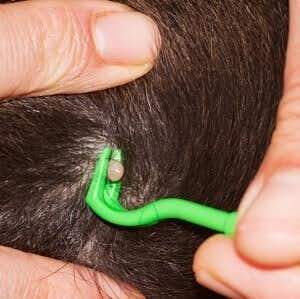
How should you remove ticks? Most people get really worried when they discover a tick burrowed into their skin. There are now so many tick-borne illnesses that we have almost lost count. There’s Lyme disease, Rocky Mountain Spotted Fever, STARI (Southern Tick-Associated Rash Illness), anaplasmosis, babesiosis, ehrlichiosis, Powassan encephalitis and Q fever. When I was a kid my dad would hold a lit cigarette to the back end of the tick in the hopes that it would let go. BAD idea. That didn’t work but did almost burn me! One reader offered a somewhat similar approach that kills ticks using mouthwash. We think it’s a bad idea.
Listerine Kills Ticks…But Do This AFTER the Tick is Removed!
Q. Last summer I learned that antiseptic mouth rinse kills ticks immediately. When I found a tick, I used to remove it and put it into rubbing alcohol where it died after a minute or so. Once I had no alcohol, but my mouthwash was handy. I wet some toilet paper with it, laid it on the tick for a few seconds and, shazam! The tick released its nasty grip. I wiped it away with the paper.
Check it out. Be sure the active ingredients match those of Listerine blue or yellow. If you put a live tick into this solution, it dies in a couple of seconds.
A. Dermatologists advise using tweezers to grasp the tick as close to the skin as possible and pull steadily (no jerking or twisting) until it lets go. There are also special tools that make it easier to grasp the tick close to the skin so you are less likely to leave the mouth parts behind. An emergency physician offered these recommendations for tick removal devices:
The People’s Pharmacy is reader supported. When you buy through links in this post, we may earn a small affiliate commission (at no cost to you).
We worry that anything that makes a tick unhappy could stimulate the release of nasty germs, such as those mentioned above. And what if the tick dies while still attached to your skin?
Other Non-Starter Tick Removal Strategies:
Putting alcohol or petroleum jelly on a tick is not recommended by health professionals. Neither is applying nail polish. Holding a hot match against the tick is just as bad as the hot end of a cigarette. Such strategies may stimulate the tick to release more nastiness into your body thereby increasing the risk for acquiring an infection.
A tick should not be handled with bare fingers, to prevent picking up the germs it may carry. Dropping it into rubbing alcohol or a mouthwash like Listerine that contains alcohol should kill it quickly. Do this after removal. If you don’t have anything like that available, you can entomb the tick in transparent adhesive tape and dispose of it.
Wash your hands carefully after disposing of the tick. If you didn’t use disposable gloves to handle the tick, use rubbing alcohol or soap and water. Apply rubbing alcohol to the area of the bite as well.
Write the date you removed the tick on a calendar. If you develop any symptoms over the course of the next few days (fever, chills, aches, pains, headache, fatigue, rash, etc.) contact your health professional immediately! Never second guess a tick bite!
Best Advice of All…Avoid Tick Bites!
If you want to listen to two extraordinary tick experts, please listen to this podcast:
Show 1380: Avoiding Lyme and Other Tick-Borne Diseases (Archive)
Half a million people may suffer symptoms of Lyme disease this year. Learn about avoiding Lyme and other tick-borne diseases.
We think our two guests are among the most knowledgeable in the country. They will tell you how to avoid tick bites in the first place! If you find the podcast helpful, please share it with friends and family! Your support keeps this website going. Perhaps your acquaintances would appreciate subscribing to our free newsletter at this link.
Please share your thoughts about ticks below in the comment section.

